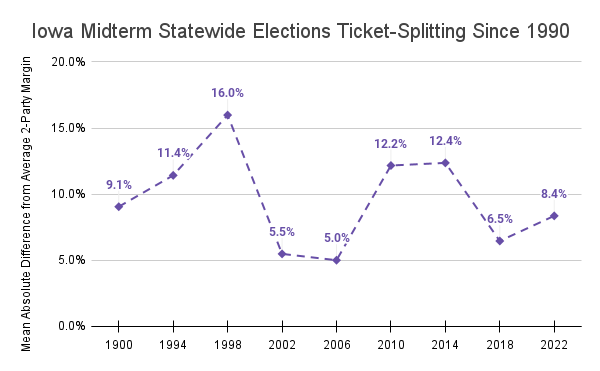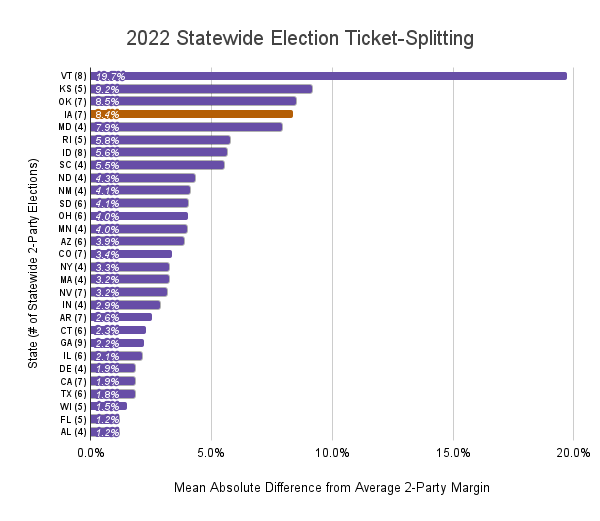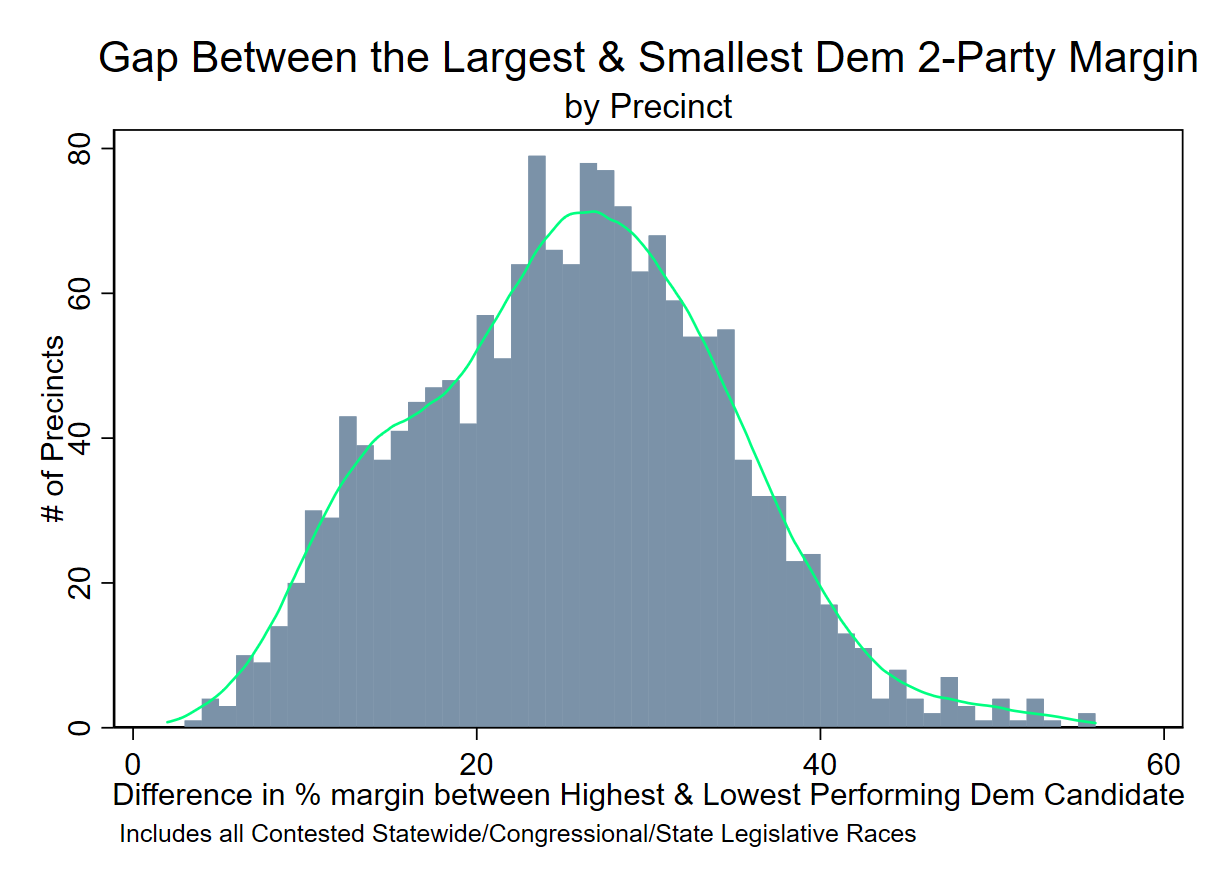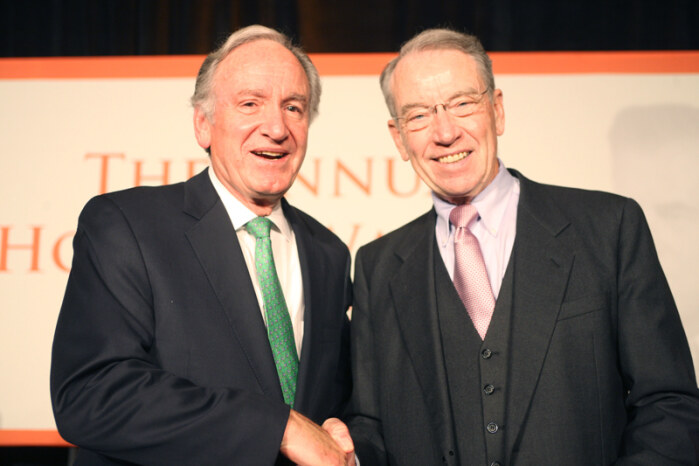Macklin Scheldrup was the Iowa Democratic Party’s Data Director in 2022. A native of Cedar Rapids, he had previously worked on the monitoring and evaluation of foreign aid projects in conflict zones including Afghanistan, Pakistan, and South Sudan.
Swing voters can seem like a mythic, unknowable creature. Depending on who you ask, they either single-handedly determine government control or don’t exist at all. But what do the 2022 election results indicate about their importance in Iowa politics? How many are there? What do they look like? And where do they live?
Ticket-splitting is the most obvious expression of a swing voter within a single election. Nationally, ticket-splitting has been on the decline throughout the 21st century. In the 2004 election, seven states split their vote for president and the U.S. Senate, meaning seven senators were elected while their state voted for the other party’s presidential nominee. When those same Class 3 Senate seats were up in the 2016 election, not a single state elected a U.S. Senator of the opposite party of their electoral votes.
But the reports of the death of ticket-splitting may be greatly exaggerated, especially in the Hawkeye State.
While the state’s overall partisanship has become a much redder hue, the percentage of the electorate willing to vote for at least one member of either party has not declined. In fact, of the 150 state legislative seats in Iowa in 2020, Trump won seven state legislative districts held by a Democrat and Biden won three held by a Republican state legislator. In 2022, Kim Reynolds carried fifteen districts held by Democratic state legislators.
One way to measure ticket-splitting is to look at the average result across multiple statewide races and then see how much each individual election results differs from that average partisanship. The mean of the absolute differences between average partisanship and individual races results is a simple and robust (albeit imperfect) measure of ticket-splitting.
Under this metric, the 2022 midterms witnessed a ”Ticket-Splitting score” of 8.4 percent across statewide elections. As shown in the chart below, this ticket-splitting elasticity was higher than the 2018 midterms.

A direct comparison of elasticity between specific election cycles is difficult because of the different numbers of statewide races being competed by both major parties as well as the impact of individual candidates. However, the overall trend of elasticity over time provides solid evidence that ticket-splitting in Iowa has not systematically declined over the past few decades (at least not in midterms).
Using this measure of ticket-splitting, Iowa appears to have a high proportion of swing voters compared to other parts of the country. By my count, 29 states had at least four statewide federal, gubernatorial, or executive office elections during the 2022 midterms. The chart below places Iowa in the top-sixth of those states by ticket-splitting score—behind only Vermont, Kansas, and Oklahoma.
Vermont and Kansas ticket-splitting happened because popular governors were re-elected despite belonging to the political party not normally associated with their respective states. Oklahoma had a very unpopular incumbent governor who won by a much smaller margin than other Republicans in the state.

Iowa had a much higher percentage of swing voters in the 2022 election than the heavily-discussed swing states Wisconsin, Georgia, Nevada, and Arizona. A swing state just means the partisanship of their electorate is near equal, not that they have a large number of swing voters. There is less of a “moveable” electorate in these states than in Iowa.
Drilling down further into precinct-level election results, we find instances of massive levels of ticket-splitting. Including Congressional and state legislative races alongside Statewide elections, the average precinct witnessed a two-party margin difference of 25.5 percent between the lowest and highest performing Democrat facing a Republican opponent on the ballot. That is the difference between losing a precinct 37 percent to 63 percent and tying.
In 72 percent of precincts, at least one Democrat had two-party margin greater than 20 percentage points more than another Democrat.

In rural Johnson County, the Hardin Township precinct gave incumbent Democratic State Senator Kevin Kinney 61 percent of the vote, for a two-party margin of 21.7 percent. At the same time, a Democratic candidate got just 33 percent of the vote in their race. This resulted in a massive 55.5 percent margin difference between two candidates from the same party, the largest in the state. From this it’s reasonable to assume that at least 27 percent of voters in the Hardin Township precinct split their ticket (55.5 divided by 2).
To determine this estimate statewide, the two-party margin gap between the highest and lowest performing Democrat is averaged (weighted by the number of voters in a precinct). The weighted average is 24.8 percent, cut in half is 12.4 percent. In other words, at least 12.4 percent of 2022 midterm voters in the state of Iowa split their ticket.
Doing a similar calculation with raw vote margin produces an estimate of more than 124,000 ticket-splitters this past cycle. Nearly as large as the entire population of Cedar Rapids. That is a huge percentage of the electorate who demonstrated they are willing to vote for a candidate from either major political party.
In Iowa at least, swing voters still have an immense impact on election results. Any campaign that ignores them does so at their own peril.
But where can these swing voters be found? And how are they different from Iowa at-large? These questions will be explored further in Part 2.
Top photo of Senator Tom Harkin (left) with Senator Chuck Grassley at the Hoover Wallace Dinner courtesy of the Harkin Institute, published with permission.


1 Comment
ticket splitting is okay - don't be a party sycophant
I have been voting since 1976 and occasionally split my vote. I voted Libertarian for governor. I won’t support Biden again as he’s too damn old and senile. Right now I plan to support RFK Jr in the Iowa Caucus but under no circumstances will I vote for Biden again. The same people who want Sen Feinstein to resign have a clear double standard for Biden. Those who vote lockstep straight ticket every time need to think perform some critical thinking. That applies to Democrats and Republicans. Don’t vote for every idiot just because they have a “D” or an “R”” after their name.
HHHdemocrat Sun 28 May 7:31 AM